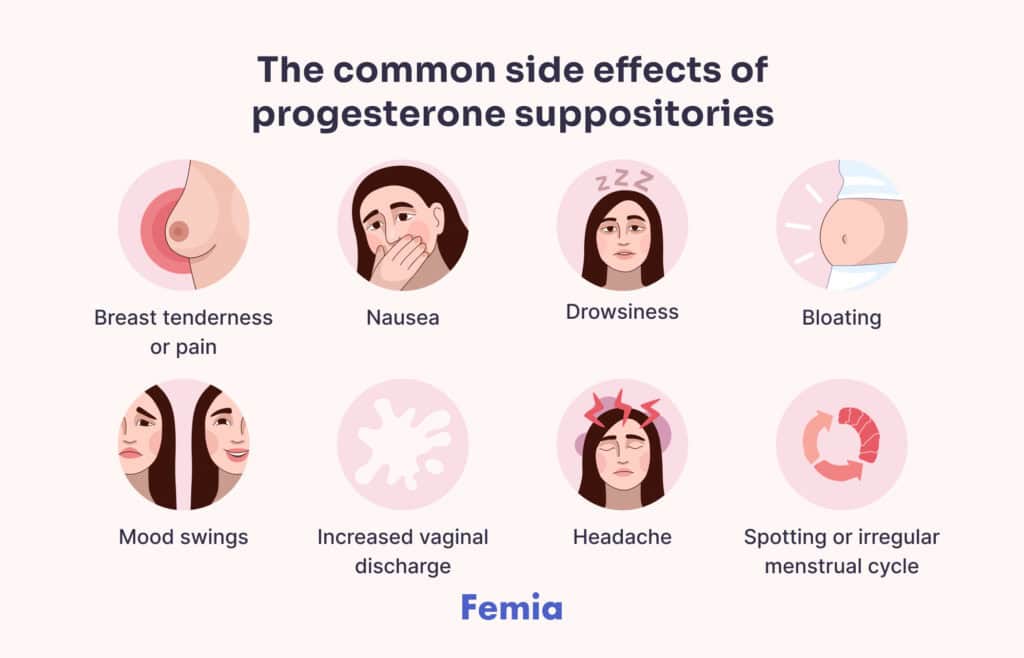Femia > Health Library > Getting Pregnant > Trying to conceive > Progesterone suppository: Uses, side effects, and what to expect
Progesterone suppository: Uses, side effects, and what to expect

- Updated Feb 11, 2025
- Published
CRAFTED BY HUMAN
Crafted by human At Femia, we provide accurate and up-to-date information at every stage of your journey, from trying to conceive, pregnancy and postnatal support. All content is created by a real person based on in-depth research and own professional experience. Femia ensures that you will receive expert advice, strict accuracy and a personalized approach from our authors/medical experts. Learn more about our editorial policy.
FACT CHECKED
Fact checked At Femia Health, we maintain the highest standards of editorial excellence in delivering content focused on helping you conceive, guiding you through pregnancy, and supporting you postpartum. Explore our content review principles to learn how we ensure the accuracy and quality of our health and lifestyle tips for every stage of your journey.
- Progesterone suppository is a hormone replacement medication that improves progesterone levels in the body. It is administered through a woman’s vagina.
- Progesterone suppositories are given to treat menstrual irregularities, hormonal imbalances, or, in fertility treatments and early pregnancy – to thicken the uterine lining and prepare it for potential embryo (baby) development. They help prevent uterine contractions during pregnancy, reducing the risk of preterm birth.
- The common side effects of progesterone suppositories include spotting, breast tenderness, fatigue, vaginal discharge or irritation, and mood swings. It is recommended to wear a panty liner to manage vaginal discharge during progesterone suppository treatment.
Progesterone suppository is a medication that contains the hormone progesterone. It is given to increase the level of progesterone in the body during fertility treatments to support pregnancy or manage gynecological conditions, like hormonal imbalances, menstrual irregularities, endometrial hyperplasia, and others.
This article discusses progesterone suppositories in detail, including their purpose, side effects, and the role of progesterone suppositories in supporting pregnancy.
Try Femia’s plan that helps remove your blocks to get pregnant
What are progesterone suppositories?
Progesterone suppository is a type of hormone replacement medication that contains progesterone and which is inserted inside a woman’s vagina.
Its primary purpose is to support pregnancy or fertility by delivering progesterone to the body, a hormone that thickens the uterine lining to prepare and maintain it for pregnancy.
👉Find out more: Estrogen and progesterone: Functions, differences, and why they matter
What do progesterone suppositories do?
So, what do progesterone suppositories do? Progesterone suppository contains the hormone progesterone which has the main purpose of helping you to become and stay pregnant.
1. Maintains pregnancy
Progesterone is a female fertility hormone that thickens the uterine lining to support fetal growth and development and suppresses uterine contractions to prevent preterm birth.
2. Regulate menstrual cycles
Progesterone suppositories also help regulate the menstrual cycle by improving progesterone levels in the body, as progesterone is required to thicken the uterine lining during the luteal phase of the menstrual cycle.
3. Treat hormonal imbalances
Progesterone suppositories are used to treat hormonal imbalances or conditions where there is low progesterone in the body.
Progesterone suppositories in pregnancy
Progesterone suppositories are also given in fertility treatments, like assisted reproductive technology (ART) to prepare the uterine lining for embryo growth and development. ART is a procedure in which a woman’s egg and a man’s sperm are fertilized outside the body to create an embryo, which is inserted in the woman’s uterus to develop into a baby.
Administering progesterone suppositories during ART can help maintain pregnancy and reduce the risk of miscarriage by preparing and nourishing the uterine lining that is necessary for fetal growth.
Vaginal progesterone vs oral or injectable forms
Here is a comparison of vaginal progesterone vs oral and injectable forms:
| Properties | Oral progesterone | Vaginal progesterone | Injectable progesterone |
|---|---|---|---|
| Absorption efficiency | Slowest absorption. | Moderate absorption. | Fastest absorption. |
| Convenience of use | Most convenient route of administration. | Slight discomfort may be felt in the vagina during administration. | Pain or slight stinging sensation at the site of needle insertion. |
| Effectiveness | 70-80% effective due to first passing metabolism. | 80-90% effective. | 90-100% effective due to fast absorption. |
| Side effects | Dizziness, drowsiness, and nausea. | Vaginal irritation. | Pain, swelling and redness at the injection site. |
Updated guidance on injectable progesterone:
In April 2023, the FDA withdrew approval for Makena (17-alpha-hydroxyprogesterone caproate) and its generics due to insufficient evidence supporting its effectiveness in preventing recurrent preterm birth. Current recommendations suggest considering alternative strategies, such as vaginal progesterone or cerclage, depending on individual patient circumstances.
Additional insights and comparisons
- Comparison of vaginal progesterone with other methods for preventing preterm birth
For women with a singleton pregnancy and a history of spontaneous preterm birth, vaginal progesterone, and cerclage are considered more effective options than 17-OHPC for preventing recurrent preterm birth. - Role of progesterone in reducing the risk of pregnancy loss
Vaginal progesterone is recommended for women with a history of recurrent pregnancy loss due to luteal phase deficiency. Evidence shows it significantly improves pregnancy outcomes when initiated early. - Progesterone’s effect on the vaginal microbiome and infections
Emerging research suggests that progesterone may influence the vaginal microbiome, potentially contributing to a protective environment against infections during pregnancy. However, further studies are needed to fully understand these effects.
Progesterone suppository side effects
Vaginal progesterone side effects can vary from person to person and can overlap with pregnancy symptoms as progesterone supports pregnancy by thickening the uterine lining. In addition, most progesterone suppository side effects are similar to pregnancy symptoms.

Hence, if you are taking progesterone in early pregnancy to support fetal development or if you get pregnant with the aid of progesterone as a part of fertility treatment, you may experience mixed symptoms of early pregnancy and progesterone side effects.
The common side effects of progesterone suppositories include:
- Breast tenderness or pain
- Nausea
- Drowsiness
- Bloating
- Mood swings
- Headache
- Increased vaginal discharge
- Spotting or irregular menstrual cycle
Some unique progesterone suppositories side effects vs pregnancy symptoms include:
| Progesterone suppository | Pregnancy symptoms |
|---|---|
| Headaches | Morning sickness |
| Mood changes or irritability | Food cravings |
| Spotting or vaginal discomfort | Increased vaginal discharge |
| Irregular menstrual cycle | No periods |
Can progesterone suppositories cause spotting?
Yes, progesterone suppository can cause mild spotting and vaginal irritation which are the side effects of progesterone. It occurs due to hormonal changes in the body, but heavy bleeding from progesterone suppositories can be a sign of miscarriage. Hence, it is best to report any spotting or bleeding to your doctor to identify any potential issues and their cause.
👉Find out more: Implantation bleeding vs. miscarriage: Key differences explained
What if I miss a dose of progesterone while pregnant?
If you miss a dose of progesterone while pregnant, contact your healthcare provider immediately for guidance. Maintaining consistent hormone levels is critical during pregnancy, and your provider will advise you on the best course of action based on your specific treatment plan.
Tips for using progesterone suppositories
Some common tips for using progesterone suppositories include:
- Wash your hands before and after using the suppository to maintain hygiene and prevent vaginal infections. Trim your nails to avoid scratches.
- Relax and lie down before entering the suppository in your vagina. You can also dip the suppository in water to enable easy insertion.
- Lie down for 10-15 minutes after entering the suppository to allow absorption and prevent the suppository from coming out.
- Wear pads or pantie liners to manage potential discharge.
- Store your suppository properly and as directed. If it melts in your hands, rinse it with cold water and refrigerate it until hardened and then use.
- Insert the suppository at the same time each day to maintain hormone levels.
Try Femia’s plan that helps remove your blocks to get pregnant
When to contact a doctor
You should consider contacting your healthcare provider if:
- You experience severe progesterone suppository side effects, like unusual or heavy vaginal bleeding, swelling in ankles or feet, and severe mood changes, like depression.
- Your periods have not started within 45 days of your previous period and you are not pregnant.
- You have any concerns regarding the potential side effects, drug interactions or missed dose of progesterone.
Questions from the Femia community
Do progesterone suppositories delay your period?
Yes, progesterone suppositories can delay your period by supporting the thickening of the uterine lining during the luteal phase, particularly in fertility treatments.
Can progesterone suppositories harm the baby?
No, progesterone suppositories do not harm the baby if used correctly and as prescribed by your doctor.
Is it normal to have cramping with progesterone suppositories?
Mild cramping or bloating can occur as a side effect of progesterone suppositories, but severe cramping can be a concern and should be reported to the doctor.
How long should I use progesterone suppositories during pregnancy?
It depends on your condition and what you’re using it for. If you are experiencing vaginal bleeding during pregnancy, progesterone suppositories are typically given until 16 weeks of pregnancy. To prevent preterm birth, progesterone suppositories are continued until the 36th-37th week of pregnancy.
The bottom line
Progesterone suppository is a hormone replacement medication that improves progesterone levels in the body, a hormone that thickens the uterine lining and prevents it from shedding, preparing the lining for potential embryo development.
The medication is prescribed to support early pregnancy, prevent preterm birth, or treat vaginal bleeding during pregnancy and relieve hormonal imbalances, and menstrual irregularities. It is also given during fertility treatments to increase progesterone levels in the body, thicken the uterine lining, and prepare it for pregnancy.
Progesterone suppositories are administered through the vagina and it is recommended to keep lying down for 10-15 minutes after administration to enable easy and complete absorption and prevent the suppository from coming out.
The common vaginal progesterone side effects include spotting, increased vaginal discharge or irritation, mood swings, breast tenderness, bloating, and headache. It is recommended to contact your doctor if the side effects become severe or persistent and spotting turns into heavy bleeding.
References
- Kolatorova, Lucie, et al. “Progesterone: A Steroid With Wide Range of Effects in Physiology as Well as Human Medicine.” International Journal of Molecular Sciences, vol. 23, no. 14, July 2022, p. 7989. https://doi.org/10.3390/ijms23147989.
- “Progesterone Use in Assisted Reproductive Technology.” Science Direct, www.sciencedirect.com/science/article/abs/pii/S1521693420300821.
- “Progestin (Oral Route, Parenteral Route, Vaginal Route).” Mayo Clinic, 1 Oct. 2024, www.mayoclinic.org/drugs-supplements/progestin-oral-route-parenteral-route-vaginal-route/description/drg-20069443.
- Alsulmi, Eman S., et al. “The Use of Progesterone During Pregnancy to Prevent Preterm Birth.” Saudi Medical Journal, vol. 41, no. 4, Apr. 2020, pp. 333–40. https://doi.org/10.15537/smj.2020.4.25036.
- “First-Pass Effect.” PubMed, 1 Jan. 2025, pubmed.ncbi.nlm.nih.gov/31869143/#:~:text=The%20first%2Dpass%20effect%20is,or%20its%20site%20of%20action.
- FIGO. “Progesterone for Recurrent Pregnancy Loss Due to Luteal Phase Deficiency.” International Journal of Gynecology & Obstetrics, vol. 151, no. 2, 2023, https://obgyn.onlinelibrary.wiley.com/doi/full/10.1002/ijgo.14717. Accessed 16 Jan. 2024.
- Nagendra, Rajkumar, et al. “A Comprehensive Review of Progesterone and Its Impact on Pregnancy.” PMC, 2023, https://pmc.ncbi.nlm.nih.gov/articles/PMC10929293/. Accessed 16 Jan. 2024.
- American College of Obstetricians and Gynecologists (ACOG). “Updated Guidance on Use of Progesterone Supplementation for Prevention of Recurrent Preterm Birth.” ACOG Practice Advisory, April 2023, https://www.acog.org/clinical/clinical-guidance/practice-advisory/articles/2023/04/updated-guidance-use-of-progesterone-supplementation-for-prevention-of-recurrent-preterm-birth. Accessed 16 Jan. 2024.
- Langer, Matt, et al. “Progesterone and Its Impact on Vaginal Microbiome and Pregnancy.” PMC, 2023, https://pmc.ncbi.nlm.nih.gov/articles/PMC7841610/. Accessed 16 Jan. 2024.

Discover the timings and symptoms of successful implantation with and without bleeding and how long after implantation bleeding you can test for pregnancy.

Does stomach pain after sex mean you are pregnant? Learn if it’s a sign of pregnancy or other health concerns. Understand the causes, symptoms, and when to seek medical advice.

Learn to distinguish between gas bubbles and baby movements during pregnancy. Understand key differences, timing, and when to consult your doctor. Expert advice from Femia.

